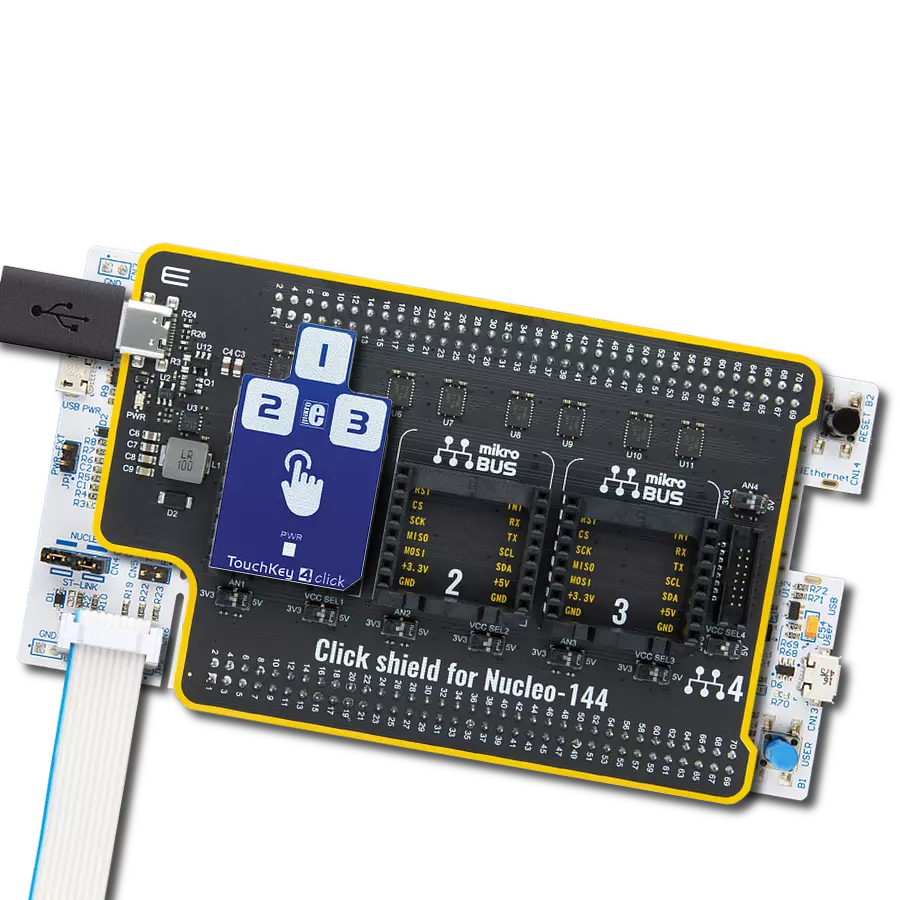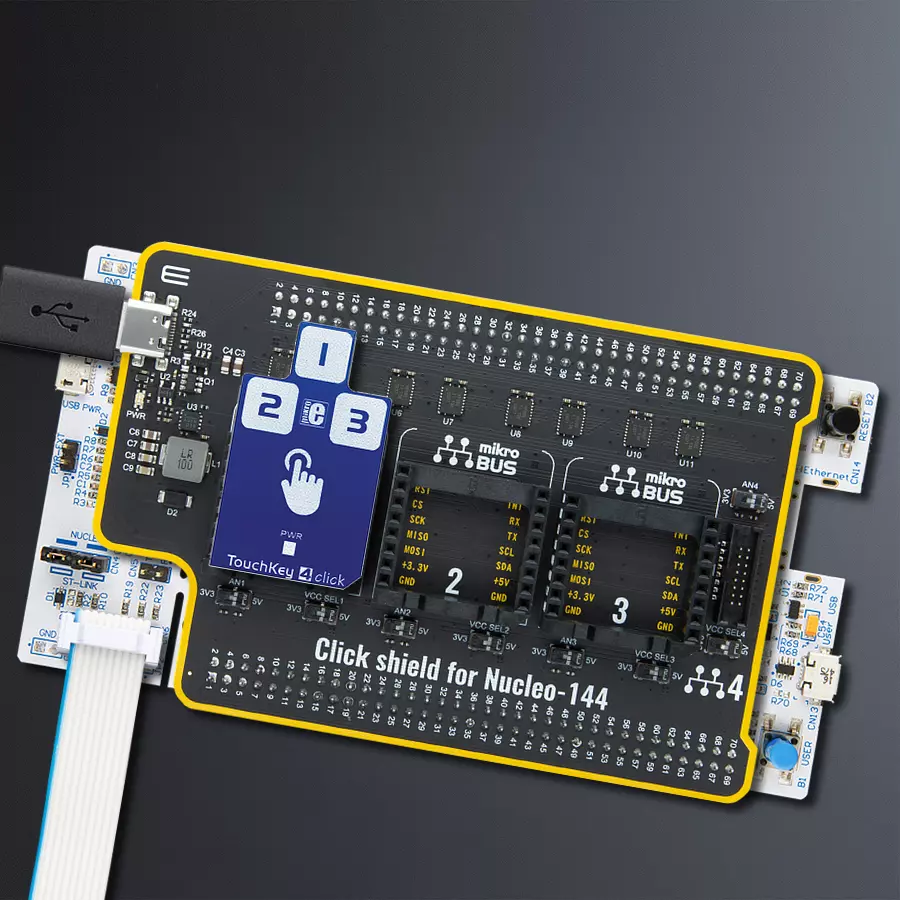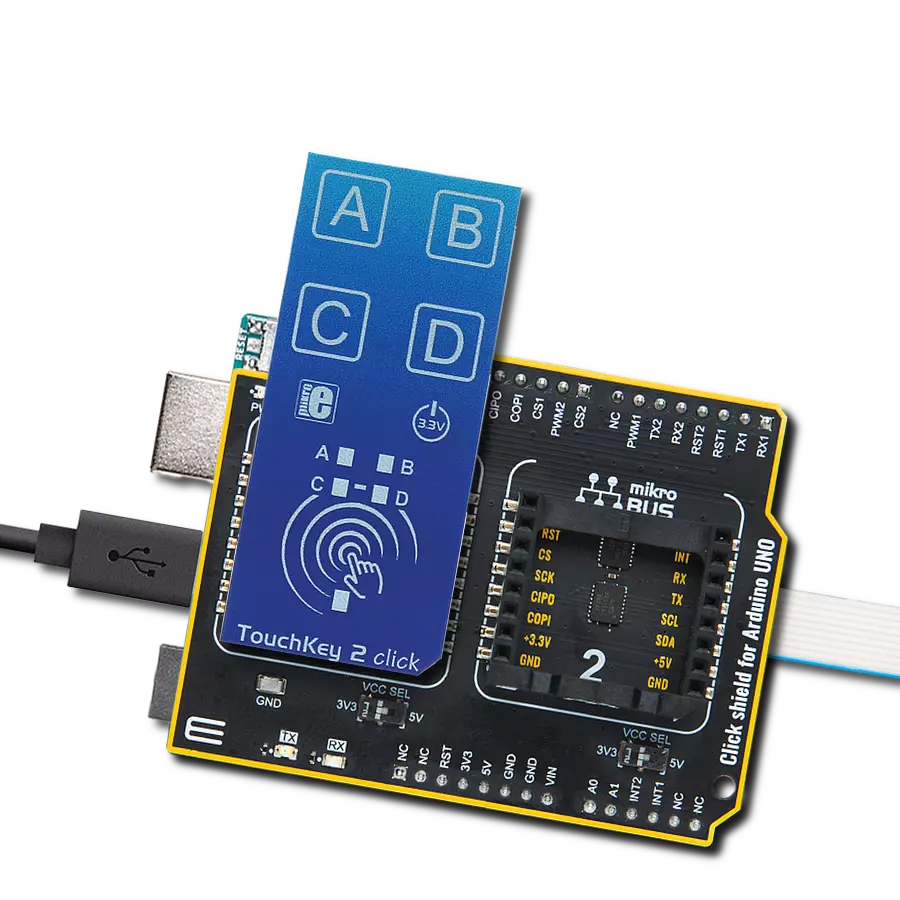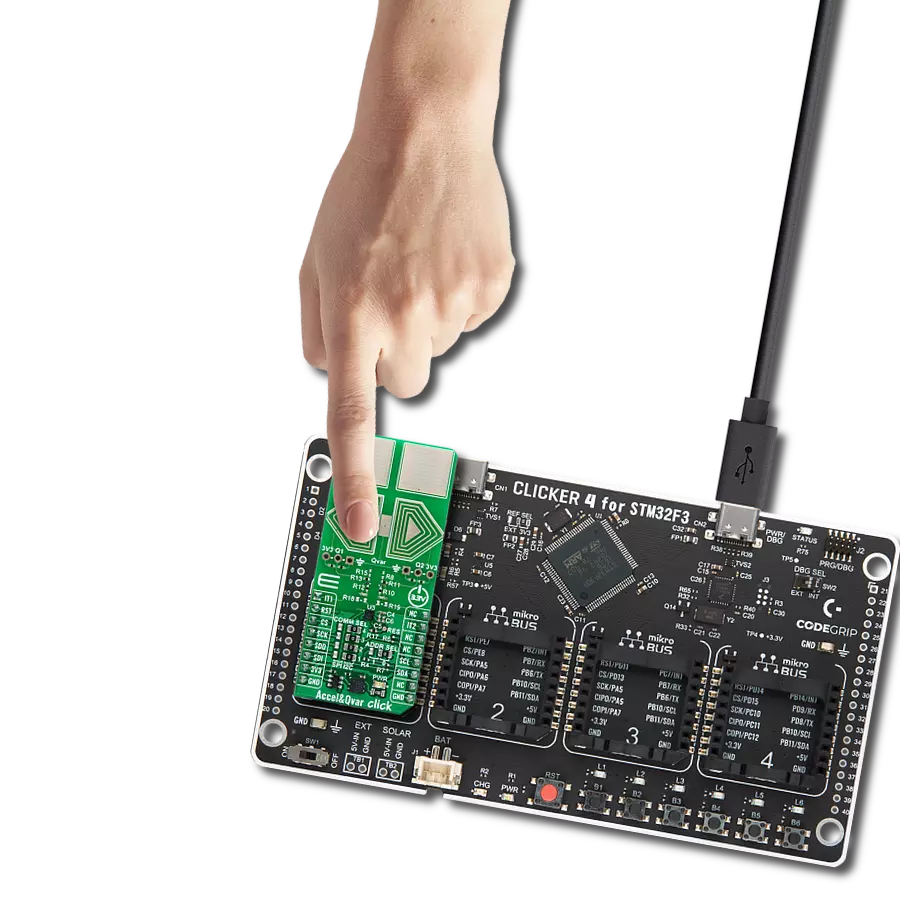Join the movement and create interfaces that come alive with touch functions
A
A
Hardware Overview
How does it work?
TouchKey 4 Click is based on the CAP1293, 3-channel capacitive touch sensor with proximity detection from Microchip. This IC has three independently configurable capacitive touch channels with the auto-calibration function. It uses the I2C protocol for the communication, with the I2C bus pins routed to the respective mikroBUS™ pins: SMCLK is the I2C clock pin, routed to the SCK pin of the mikroBUS™ and the SMDATA is the I2C data pin, routed to the SDA pin of the mikroBUS™. Additionally, an #ALERT pin is routed to the mikroBUS™ INT pin, which triggers interrupts on the host MCU. The board has three PCB pads used to sense touch or proximity events. These pads are the only elements on the top side of the board, allowing the installation of the protective acrylic glass layer. The capacitive sensor channels feature a programmable sensitivity threshold and an automatic recalibration to compensate for environmental changes. The device can work in several power modes, with separate input settings for the Active and Standby modes. The recalibration procedure can be triggered either automatically or on-demand, and it is used to set the base register value for the “not touched” state of the input channel. The CAP1293 IC also integrates sections that provide efficient interference protection. The EMI and RFI detection
sections protect by discarding the corrupted bytes if the detected noise threshold is exceeded. Also, false input readings, such as the negative values and “stuck button” events, are handled by the internal algorithms, which will set the respective bits to indicate the problem, and can be set to trigger a recalibration procedure. In general, the device always reverts to a power-saving mode when idling. If the programmed cycling time through all the enabled channels is long enough, sampling all the enabled channels will be finished before the cycle ends. When this happens, the device will revert to a power-saving mode, waiting for another cycle to begin. If there is insufficient time to sample all the channels, the device will not revert to a power-saving mode. This will affect the overall power consumption. Multiple touch pattern detection (MTPD) sets the pattern to generate a touch event. This pattern may consist of multiple specific sensors touched at once, a minimal number of touched sensors, or when their noise flag bit is set in the status register. This function can be used to detect a closed lid or similar event. The interrupt engine differentiates between the simple touch and touch and holds events. The interrupt can be generated once when a pad touch is detected/released or repeatedly generated while the pad is touched.
A special case of touch detection is the Power Button mode. This mode requires the button to be pressed for a programmed interval before an interrupt is generated. This allows a simple Power Button functionality to be implemented in any application. The interrupt can be generated for various other events, such as the failure to calibrate and similar auxiliary events. The press and hold mode is useful for developing volume control applications. The programmable interval timer is started after the first touch event on a specific channel. The interrupt is generated in the programmed intervals if no release event is detected after the timer expires. This can be used to implement volume up/down buttons, light-dimming buttons, and similar applications. Any interrupt event will drive the #ALERT pin to a LOW logic state. This pin is routed to the mikroBUS™ INT pin and is used to trigger an interrupt event on the host MCU. More information about the registers and their functions can be found in the CAP1293 IC datasheet. However, the provided click library offers a function for easy and simple control of the Touch Key 4 Click. The provided application example demonstrates their functionality and can be used as a reference for custom projects.
Features overview
Development board
Nucleo-144 with STM32F413ZH MCU board offers an accessible and adaptable avenue for users to explore new ideas and construct prototypes. It allows users to tailor their experience by selecting from a range of performance and power consumption features offered by the STM32 microcontroller. With compatible boards, the
internal or external SMPS dramatically decreases power usage in Run mode. Including the ST Zio connector, expanding ARDUINO Uno V3 connectivity, and ST morpho headers facilitate easy expansion of the Nucleo open development platform. The integrated ST-LINK debugger/programmer enhances convenience by
eliminating the need for a separate probe. Moreover, the board is accompanied by comprehensive free software libraries and examples within the STM32Cube MCU Package, further enhancing its utility and value.
Microcontroller Overview
MCU Card / MCU

Architecture
ARM Cortex-M4
MCU Memory (KB)
1536
Silicon Vendor
STMicroelectronics
Pin count
144
RAM (Bytes)
327680
You complete me!
Accessories
Click Shield for Nucleo-144 comes equipped with four mikroBUS™ sockets, with one in the form of a Shuttle connector, allowing all the Click board™ devices to be interfaced with the STM32 Nucleo-144 board with no effort. This way, MIKROE allows its users to add any functionality from our ever-growing range of Click boards™, such as WiFi, GSM, GPS, Bluetooth, ZigBee, environmental sensors, LEDs, speech recognition, motor control, movement sensors, and many more. Featuring an ARM Cortex-M microcontroller, 144 pins, and Arduino™ compatibility, the STM32 Nucleo-144 board offers limitless possibilities for prototyping and creating diverse applications. These boards are controlled and powered conveniently through a USB connection to program and efficiently debug the Nucleo-144 board out of the box, with an additional USB cable connected to the USB mini port on the board. Simplify your project development with the integrated ST-Link debugger and unleash creativity using the extensive I/O options and expansion capabilities. This Click Shield also has several switches that perform functions such as selecting the logic levels of analog signals on mikroBUS™ sockets and selecting logic voltage levels of the mikroBUS™ sockets themselves. Besides, the user is offered the possibility of using any Click board™ with the help of existing bidirectional level-shifting voltage translators, regardless of whether the Click board™ operates at a 3.3V or 5V logic voltage level. Once you connect the STM32 Nucleo-144 board with our Click Shield for Nucleo-144, you can access hundreds of Click boards™, working with 3.3V or 5V logic voltage levels.
Used MCU Pins
mikroBUS™ mapper
Take a closer look
Click board™ Schematic

Step by step
Project assembly
Track your results in real time
Application Output
1. Application Output - In Debug mode, the 'Application Output' window enables real-time data monitoring, offering direct insight into execution results. Ensure proper data display by configuring the environment correctly using the provided tutorial.

2. UART Terminal - Use the UART Terminal to monitor data transmission via a USB to UART converter, allowing direct communication between the Click board™ and your development system. Configure the baud rate and other serial settings according to your project's requirements to ensure proper functionality. For step-by-step setup instructions, refer to the provided tutorial.

3. Plot Output - The Plot feature offers a powerful way to visualize real-time sensor data, enabling trend analysis, debugging, and comparison of multiple data points. To set it up correctly, follow the provided tutorial, which includes a step-by-step example of using the Plot feature to display Click board™ readings. To use the Plot feature in your code, use the function: plot(*insert_graph_name*, variable_name);. This is a general format, and it is up to the user to replace 'insert_graph_name' with the actual graph name and 'variable_name' with the parameter to be displayed.

Software Support
Library Description
This library contains API for TouchKey 4 Click driver.
Key functions:
touchkey4_detect_touch- This function detects touch on sensor inputs and checks is touch detected or releasedtouchkey4_set_active_mode- This function puts device in Active mode and enables desired inputs in Active modetouchkey4_set_standby_mode- This function puts device in Standby mode and enables desired inputs in Standby mode.
Open Source
Code example
The complete application code and a ready-to-use project are available through the NECTO Studio Package Manager for direct installation in the NECTO Studio. The application code can also be found on the MIKROE GitHub account.
/*!
* \file
* \brief TouchKey4 Click example
*
* # Description
* This demo performs touch & release detection Click functionality.
*
* The demo application is composed of two sections :
*
* ## Application Init
* Device and driver initialization.
*
* ## Application Task
* Calls function to check touch detection (is interrupt occured) and shows message on
* USB UART if touch is detected or if touch is released on enabled inputs.
*
* *note:*
* <pre>
* TouchKey 4 is configured to work in Combo mode (Active and Standby mode). Input 1 is
* enabled in Active mode, input 3 is enabled in Standby mode, and input 2 is enabled to
* work in both modes. In this example the interrupt will be generated when touch is
* detected and when touch is released.
* Standby mode should be used when fewer sensor inputs are enabled, and when
* they are programmed to have more sensitivity.
* Sometimes it is neccessary to cycle the board power supply if Click doesn't work.
* </pre>
* \author MikroE Team
*
*/
// ------------------------------------------------------------------- INCLUDES
#include "board.h"
#include "log.h"
#include "touchkey4.h"
// ------------------------------------------------------------------ VARIABLES
static touchkey4_t touchkey4;
static log_t logger;
static uint8_t sensor_results[ 3 ];
static uint8_t cnt;
// ------------------------------------------------------ APPLICATION FUNCTIONS
void application_init ( void )
{
log_cfg_t log_cfg;
touchkey4_cfg_t cfg;
/**
* Logger initialization.
* Default baud rate: 115200
* Default log level: LOG_LEVEL_DEBUG
* @note If USB_UART_RX and USB_UART_TX
* are defined as HAL_PIN_NC, you will
* need to define them manually for log to work.
* See @b LOG_MAP_USB_UART macro definition for detailed explanation.
*/
LOG_MAP_USB_UART( log_cfg );
log_init( &logger, &log_cfg );
log_info( &logger, "---- Application Init ----" );
// Click initialization.
touchkey4_cfg_setup( &cfg );
TOUCHKEY4_MAP_MIKROBUS( cfg, MIKROBUS_1 );
touchkey4_init( &touchkey4, &cfg );
Delay_ms ( 1000 );
touchkey4_default_cfg( &touchkey4 );
log_info( &logger, "---- Configured and ready ----" );
}
void application_task ( void )
{
touchkey4_detect_touch( &touchkey4, sensor_results );
for ( cnt = 0; cnt < 3; cnt++ )
{
if ( sensor_results[ cnt ] == 1 )
{
if ( cnt == 0 )
{
log_info( &logger, "Input 1 is touched\r\n" );
}
else if ( cnt == 1 )
{
log_info( &logger, "Input 2 is touched\r\n" );
}
else
{
log_info( &logger, "Input 3 is touched\r\n" );
}
}
else if ( sensor_results[ cnt ] == 2 )
{
if ( cnt == 0 )
{
log_info( &logger, "Input 1 is released\r\n" );
}
else if ( cnt == 1 )
{
log_info( &logger, "Input 2 is released\r\n" );
}
else
{
log_info( &logger, "Input 3 is released\r\n" );
}
}
}
Delay_ms ( 300 );
}
int main ( void )
{
/* Do not remove this line or clock might not be set correctly. */
#ifdef PREINIT_SUPPORTED
preinit();
#endif
application_init( );
for ( ; ; )
{
application_task( );
}
return 0;
}
// ------------------------------------------------------------------------ END


































